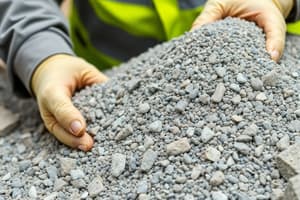Podcast
Questions and Answers
What is the main purpose of the Aggregate Crushing Value Test?
What is the main purpose of the Aggregate Crushing Value Test?
- To measure the amount of water an aggregate can absorb.
- To assess the toughness of aggregates by measuring the percentage of fines produced after applying an impact load.
- To assess the strength of aggregates by measuring the percentage of fines generated after applying a compressive load. (correct)
- To determine the particle size distribution of aggregates.
Which of the following tests is NOT directly related to the evaluation of an aggregate's resistance to wear or impact?
Which of the following tests is NOT directly related to the evaluation of an aggregate's resistance to wear or impact?
- Sieve Analysis (correct)
- Aggregate Impact Value Test
- Aggregate Abrasion Test
- Aggregate Crushing Value Test
Which test is used to classify aggregates as coarse or fine based on their particle size distribution?
Which test is used to classify aggregates as coarse or fine based on their particle size distribution?
- Aggregate Abrasion Test
- Sieve Analysis (correct)
- Water Absorption Test
- Aggregate Impact Value Test
What does the Water Absorption Test reveal about an aggregate?
What does the Water Absorption Test reveal about an aggregate?
Which of the following tests is used to assess the toughness of aggregates?
Which of the following tests is used to assess the toughness of aggregates?
What does the Softening Point Test measure in bitumen?
What does the Softening Point Test measure in bitumen?
Which test is used to determine the stability and flow properties of bituminous mixtures?
Which test is used to determine the stability and flow properties of bituminous mixtures?
What does the K-Slump Test assess in fresh concrete?
What does the K-Slump Test assess in fresh concrete?
Which method is typically used to measure the fineness of cement?
Which method is typically used to measure the fineness of cement?
What does the Penetration of Bitumen test measure?
What does the Penetration of Bitumen test measure?
Which test is used to determine the tensile strength of concrete?
Which test is used to determine the tensile strength of concrete?
What does the Rebound Hammer Test primarily assess?
What does the Rebound Hammer Test primarily assess?
Which test evaluates the ductility of steel reinforcement?
Which test evaluates the ductility of steel reinforcement?
What is the purpose of the Ultrasonic Pulse Velocity Test?
What is the purpose of the Ultrasonic Pulse Velocity Test?
The Brinell Hardness Test measures which property of steel?
The Brinell Hardness Test measures which property of steel?
Which test assesses tensile properties through sudden impact?
Which test assesses tensile properties through sudden impact?
Why is Construction Material Testing (CMT) critical for construction projects?
Why is Construction Material Testing (CMT) critical for construction projects?
How is the fineness of cement measured in tests?
How is the fineness of cement measured in tests?
What does the Compressive Strength Test primarily assess in concrete?
What does the Compressive Strength Test primarily assess in concrete?
How does curing affect the concrete after it is placed?
How does curing affect the concrete after it is placed?
What can happen if concrete is too pasty during mixing?
What can happen if concrete is too pasty during mixing?
Which equipment specifically conducts compression tests on concrete specimens?
Which equipment specifically conducts compression tests on concrete specimens?
What is the primary purpose of the Flow Table in concrete testing?
What is the primary purpose of the Flow Table in concrete testing?
What is the consequence of improper curing in concrete construction?
What is the consequence of improper curing in concrete construction?
What is the primary function of the Le Chatelier Mold?
What is the primary function of the Le Chatelier Mold?
Which device is used to conduct a Concrete Slump Test?
Which device is used to conduct a Concrete Slump Test?
What is the significance of identifying the transportable moisture limit in solid bulk cargoes through the flow test?
What is the significance of identifying the transportable moisture limit in solid bulk cargoes through the flow test?
What aspect of concrete does the Flexural Testing Machine evaluate?
What aspect of concrete does the Flexural Testing Machine evaluate?
What is the capacity of the Le Chatelier Flask?
What is the capacity of the Le Chatelier Flask?
What does the Cement Mortar Permeability Apparatus measure?
What does the Cement Mortar Permeability Apparatus measure?
How long does it take for the Le Chatelier Water Bath to reach boiling point?
How long does it take for the Le Chatelier Water Bath to reach boiling point?
What characteristic does the Air Content Test measure?
What characteristic does the Air Content Test measure?
What type of specimens can the Cement Mortar Permeability Apparatus accommodate?
What type of specimens can the Cement Mortar Permeability Apparatus accommodate?
What does the consistency in concrete refer to during the Concrete Slump Test?
What does the consistency in concrete refer to during the Concrete Slump Test?
What is the main goal of the soundness test conducted on cement?
What is the main goal of the soundness test conducted on cement?
What does the Vicat apparatus measure?
What does the Vicat apparatus measure?
What is the purpose of the Flow Cone Apparatus?
What is the purpose of the Flow Cone Apparatus?
What property of cement does the specific gravity test measure?
What property of cement does the specific gravity test measure?
What is the main purpose of the Flame Photometer in cement testing?
What is the main purpose of the Flame Photometer in cement testing?
What is the standard consistency of cement paste defined as?
What is the standard consistency of cement paste defined as?
What is the main concern related to unstable volume changes in cement during setting and hardening?
What is the main concern related to unstable volume changes in cement during setting and hardening?
What is the automatic mortar mixer primarily used for?
What is the automatic mortar mixer primarily used for?
Flashcards
Thermal Properties Testing
Thermal Properties Testing
Measures how well materials transfer heat; varies with substance.
Electrical Properties Testing
Electrical Properties Testing
Evaluates materials under electrical stresses like dust, fog, and high voltage.
Non-destructive Testing
Non-destructive Testing
Analyzes materials without causing any damage to them or their structures.
Sieve Analysis
Sieve Analysis
Signup and view all the flashcards
Water Absorption Test
Water Absorption Test
Signup and view all the flashcards
Bitumen Content
Bitumen Content
Signup and view all the flashcards
Flash Point of Bitumen
Flash Point of Bitumen
Signup and view all the flashcards
Softening Point Test
Softening Point Test
Signup and view all the flashcards
Slump Test
Slump Test
Signup and view all the flashcards
Ductility of Bitumen
Ductility of Bitumen
Signup and view all the flashcards
Compression Strength Test
Compression Strength Test
Signup and view all the flashcards
Flexural Strength Test
Flexural Strength Test
Signup and view all the flashcards
Rebound Hammer Test
Rebound Hammer Test
Signup and view all the flashcards
Ultrasonic Pulse Velocity Test
Ultrasonic Pulse Velocity Test
Signup and view all the flashcards
Tensile Strength Test (Steel)
Tensile Strength Test (Steel)
Signup and view all the flashcards
Bend Test
Bend Test
Signup and view all the flashcards
Brinell Hardness Test
Brinell Hardness Test
Signup and view all the flashcards
Fineness Test of Cement
Fineness Test of Cement
Signup and view all the flashcards
Initial Setting Time
Initial Setting Time
Signup and view all the flashcards
Final Setting Time
Final Setting Time
Signup and view all the flashcards
Standard Consistency Test
Standard Consistency Test
Signup and view all the flashcards
Soundness of Cement
Soundness of Cement
Signup and view all the flashcards
Specific Gravity of Cement
Specific Gravity of Cement
Signup and view all the flashcards
Vicat Needle Apparatus
Vicat Needle Apparatus
Signup and view all the flashcards
Flow Cone Apparatus
Flow Cone Apparatus
Signup and view all the flashcards
Bulk Density of Cement Set
Bulk Density of Cement Set
Signup and view all the flashcards
Le Chatelier Mold
Le Chatelier Mold
Signup and view all the flashcards
Le Chatelier Flask
Le Chatelier Flask
Signup and view all the flashcards
Le Chatelier Water Bath
Le Chatelier Water Bath
Signup and view all the flashcards
Cement Mortar Permeability Apparatus
Cement Mortar Permeability Apparatus
Signup and view all the flashcards
Concrete Testing
Concrete Testing
Signup and view all the flashcards
Air Content Test
Air Content Test
Signup and view all the flashcards
Concrete Slump Test
Concrete Slump Test
Signup and view all the flashcards
Consistency in Concrete
Consistency in Concrete
Signup and view all the flashcards
Curing
Curing
Signup and view all the flashcards
Flow Table Test
Flow Table Test
Signup and view all the flashcards
Compression Testing Machine
Compression Testing Machine
Signup and view all the flashcards
Flow Table Equipment
Flow Table Equipment
Signup and view all the flashcards
Flexural Testing Machine
Flexural Testing Machine
Signup and view all the flashcards
Moisture in Curing
Moisture in Curing
Signup and view all the flashcards
Study Notes
Construction Materials
- Defined as materials, supplies, fixtures, or equipment
- Seven common types:
- Steel: Alloy of iron and carbon, stronger and more resistant to fracture
- Aggregate: Broad category of particulate material (sand, gravel, crushed stone, slag, recycled concrete) used in construction
- Cement: Adhesive substances, binding materials in construction
- Bitumen: Mixture of hydrocarbons, used for road surfacing and roofing
- Concrete: Composite material of aggregates bound by a liquid binder (cement)
- Asphalt: Mixture of aggregates, binder, and filler for roads and areas
- Masonry: Construction using individual units (bricks) bound with mortar
Materials Testing
- Respected and established technique
- Used to determine physical and mechanical properties of materials
- Examining various materials, from human hair to composite materials
- Five major categories:
- Mechanical: Destructive testing, revealing material properties under dynamic or static forces
- Thermal: Measuring materials' ability to transfer heat considering factors
- structure
- density
- humidity
- pressure
- temperature
Testing for Electrical Properties
- Materials are subjected to electrical stresses under various conditions (liquid contaminants, dust, fog)
Testing for Resistance to Corrosion, Radiation and Biological Deterioration
- Evaluating material breakdown under exposure to environments
- Techniques have increased in recent years
Aggregates Testing
- Sieve Analysis: Determines particle size distribution of aggregates (coarse/fine)
- Water Absorption Test: Measures water absorption of aggregate impacting concrete mixes
- Aggregate Impact Value Test: Measures aggregate toughness (fines produced after impact)
- Aggregate Abrasion Test: Determines durability of aggregates to wear through Los Angeles and Deval abrasion tests
- Aggregate Crushing Value Test: Measures the percentage of fines generated after applying a compressive load
Bitumen Testing
- Determining Bitumen Content: Measures the percentage of bitumen in bituminous mixtures using ignition or solvent extraction
- Determining the Flash and Fire Point of Bitumen: Determines the temperature at which bitumen develops vapors that ignite
- Penetration of Bitumen: Measures hardness of bitumen by its penetration depth
- Softening Point Test: Identifies bitumen's softening temperature using Ring and Ball test
- Determining the Specific Gravity of Bitumen: Ratio of bitumen density to water density
- Determining the Ductility Test: Measures bitumen's elongation
Cement Testing (Cement/Mortar)
- Fineness Test: Measures particle size (surface area) of cement
- Soundness Test: Checks cement's stability against volume changes during setting and hardening
- Consistency Test: Using Vicat needle apparatus
- Setting Time Test: Measures time taken for cement paste to turn from fluid to hardened state
Fresh Concrete Testing
- Slump Test: Measures workability (flow) and consistency of fresh concrete; assesses slump of cone
- Compacting Factor Test: Grades of compaction (particularly for low workability mixes)
- Vebe Test: Measures time for fresh concrete to fully compact under vibration (useful for very dry mixes)
- K-Slump Test: Rapid test of workability and consistency
Hardened Concrete Testing
- Compression Strength Test: Measures concrete compressive strength using cube or cylinder specimens
- Flexural Strength Test: Measures tensile strength of concrete by applying a load on a beam specimen
- Rebound Hammer Test: Non-destructive test estimating compressive strength of hardened concrete
- Ultrasonic Pulse Velocity (UPV) Test: Measures ultrasonic wave velocity through concrete to assess quality, uniformity, and strength
Steel Reinforcement Testing
- Tensile Strength Test: Determines steel reinforcement properties (yield and ultimate strength)
- Bend Test: Assesses steel ductility by bending a specimen
- Re-bend Test: Evaluates strain aging effects by re-bending
- Shear Test: Evaluates shear strength of steel reinforcement
Other Concrete Materials Testing
- Initial and Final Setting Time Test: Measures time taken for cement paste to lose its plasticity (initial and final setting times)
- Standard Consistency Test: Measures required water percentage in 300g cement weight; a Vicat plunger must penetrate to 33-35mm
- Soundness Test: Evaluate stability of cement against alterations during setting and hardening
- Specific Gravity Test: Calculates a ratio between the density of cement and water concerning volume relationships
Equipment Used in Concrete and Cement Testing
- Numerous apparatus and devices are listed including:
- Le Chatelier Water Bath
- Gauging Trowel
- VeeBee Concistometer
- Slump Test Apparatus
- Kelley Apparatus
- Compaction Factor Apparatus
- Cube Mold
- Cylindrical Mold
- Beam Mold
- Flow Table
- Compression Testing Machines
- Automatic Mortar Mixer
Additional Notes
- Various procedures and testing apparatus are detailed for the various concrete components like cement, mortar, and concrete itself
- Different tests, including those for curing times, are described
Studying That Suits You
Use AI to generate personalized quizzes and flashcards to suit your learning preferences.




